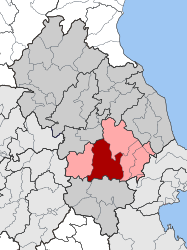Nikaia, Larissa
In this article, we will delve into the fascinating world of Nikaia, Larissa, with the aim of exploring the different aspects, meanings and repercussions that this concept encompasses. From its origins to its relevance today, we will cover each facet of Nikaia, Larissa in a detailed and exhaustive manner, with the aim of providing a complete understanding of this topic. Through analysis, reflections and concrete examples, we seek to offer the reader a comprehensive and enriching vision that allows delving into the knowledge of Nikaia, Larissa and its relevance in the contemporary context.
Nikaia
Νίκαια | |
|---|---|
| Coordinates: 39°34′N 22°28′E / 39.567°N 22.467°E | |
| Country | Greece |
| Administrative region | Thessaly |
| Regional unit | Larissa |
| Municipality | Kileler |
| Area | |
| • Municipal unit | 279.562 km2 (107.939 sq mi) |
| • Community | 60.529 km2 (23.370 sq mi) |
| Population (2021)[1] | |
| • Municipal unit | 5,436 |
| • Municipal unit density | 19/km2 (50/sq mi) |
| • Community | 3,332 |
| • Community density | 55/km2 (140/sq mi) |
| Time zone | UTC+2 (EET) |
| • Summer (DST) | UTC+3 (EEST) |
| Vehicle registration | ΡΙ |
Nikaia (Greek: Νίκαια) is a town and a former municipality in the Larissa regional unit, Thessaly, Greece. Located 4 km south of Larissa city, it forms a part of Larissa's metropolitan area, that lies in the Thessalian plain. Since the 2011 local government reform, it has been part of the municipality Kileler, of which it is the seat and a municipal unit.[2] The population is 5,436 (2021). The municipal unit has an area of 279.562 km2.[3]
References
- ^ "Αποτελέσματα Απογραφής Πληθυσμού - Κατοικιών 2021, Μόνιμος Πληθυσμός κατά οικισμό" [Results of the 2021 Population - Housing Census, Permanent population by settlement] (in Greek). Hellenic Statistical Authority. 29 March 2024.
- ^ "ΦΕΚ B 1292/2010, Kallikratis reform municipalities" (in Greek). Government Gazette.
- ^ "Population & housing census 2001 (incl. area and average elevation)" (PDF) (in Greek). National Statistical Service of Greece.

